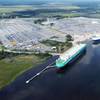Vancouver Port Cargo Volumes Hit Record in 2018
The Vancouver Fraser Port Authority has released the 2018 year-end statistics for cargo through the Port of Vancouver. The second consecutive year of record cargo volumes reflects Canada’s growing trade, said a press release.
Overall cargo volume through Canada’s largest port reached a record high of 147 million tonnes, up 3.5 per cent from 2017, it said.
"One of the port’s biggest strengths continues to be the ability to accommodate the most diversified range of cargo of any port in North America. Sectors that experienced strong growth last year include containers, potash, canola products and barley, all of which hit new records in 2018," it added.
In 2018, container volumes, measured in 20-foot equivalents or TEUs, increased by 4.4 per cent to a record 3.4 million TEUs. In Vancouver, containers arrive filled with appliances, clothing and other consumer products as well as auto parts and manufactured goods from Asia. They leave loaded with Canadian grain, lumber and food products, among other goods.
“Canada’s international trade is growing. The port authority and all those who make up the Port of Vancouver are taking steps to ensure the port will be ready to handle the anticipated increase in cargo through Canada’s west coast,” said Robin Silvester, president and chief executive officer of the Vancouver Fraser Port Authority, the federal agency responsible for overseeing the Port of Vancouver. “This includes partnering with terminal operators to expand and improve operations in preparation to meet the expected increased demand.”
Even with the additional capacity provided by such improvements, forecasts from independent experts show it won’t be enough to manage Canada’s future trade demand. This highlights the need for the port authority’s proposed new container terminal at Roberts Bank.
The proposed Roberts Bank Terminal 2 Project, which is currently undergoing a review by an independent panel appointed by the federal Minister of Environment and Climate Change, would help realize our nation’s trade potential by providing the marine terminal capacity needed to meet the forecasted demand for trade of goods in containers, serving Canadians well into the future.
The cruise industry in Vancouver also experienced stable growth as demand for cruises to Alaska continues to increase. In 2018, there was a 5.5 per cent increase in passenger numbers to the Port of Vancouver.
“Last year’s success is due to port terminals, tenants, railways, marine shippers, truckers, and our government and other partners, all of whom are continuing to invest in response to growing trade,” continued Silvester. “I’d like to thank all of our port stakeholders for their commitment to contribute to a more fluid and efficient supply chain and increased capacity at Canada’s largest port.”










